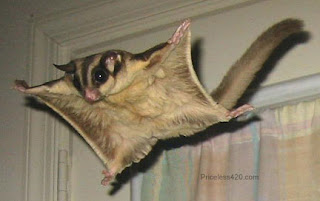Animal Wildlife | Flying Squirrel | The flying squirrel is a medium-sized rodent, closely related to the squirrels found in woodlands and across grasslands around the world. Flying squirrels tend to be slightly larger in size than the common squirrel. Despite the name, flying squirrels cannot actually fly, although they can be airborne for a remarkable length of time. Instead of flying, flying squirrels move through the air by gliding (normally between the trees), with the longest recorded glide of a flying squirrel being nearly 90 meters.
Flying squirrels have a furry, stretchy membrane that stretches between their front and back legs. When the flying squirrel needs to get away quickly, it opens it's arms and legs out and uses the membrane like a parachute. Flying squirrels also have large eyes, and stubby flattened tails.
There are nearly 50 different species of flying squirrel found in forests around the world. Flying squirrels range in size and colour depending on the species of flying squirrel. The largest species of flying squirrel is the Woolly flying squirrel, which is found in Pakistan and the smallest flying squirrel species is the pygmy flying squirrel, found in the jungles of Borneo and Malaysia.
Flying squirrels are omnivorous animals meaning that their diet is based on both plant and animal matter. The flying squirrel is a nocturnal animal, so it forages for food under the cover of night as flying squirrels are not able to easily escape the birds of prey that hunt during the day. Flying squirrels eat nuts, seeds, fruits, berries, insects and bird eggs. Due to their small size, flying squirrels have numerous natural predators wherever they live in the world. Domestic cats, raccoons, snakes, birds of prey, foxes, dogs and coyotes are all primary predators of the flying squirrel.
Flying squirrels are known to breed twice a year, in the early spring and again in the summer. After a gestation period of roughly 40 days, the female flying squirrel gives birth to between 2 and 7 baby flying squirrels, which are blind and naked when they are born. The baby flying squirrels develop fur and open their eyes when they are about a month old. The young flying squirrels begin to glide and forage with their mother when they are roughly 2 months old.
Tags: flying squirrel life span, flying squirrel wireless, flying squirrel removal, flying squirrel massachusetts, flying squirrel georgia, flying squirrel in attic, flying squirrel attic, albino flying squirrel, flying squirrel infestation, flying tree squirrel, flying squirrel tree service, flying squirrel connecticut, flying squirrel maryland, northern flying squirrel range







Dude the first picture is a sugar glider not a flying squirrel
ReplyDeleteNice post. You describe the information of Flying squirrel very well..I really appreciate your work, keep it up.Visit Thoroughspect Flying squirrel
ReplyDeleteI just saw one on my friends house. It came in the fire place. I didn't think they lived here
ReplyDeleteWow I just saw one in my friend's house. It came in through the fire place. I didn't think they lived in this climate
ReplyDeleteAs mentioned before (& still not corrected!) that first pic is most certainly NOT a Flying Squirrel but a rather different Sugar Glider - which are in fact marsupials and not mammals/rodents like true Flying Squirrels. Though perhaps superficially similar, they are worlds apart. This needs correcting!
ReplyDelete